BY LETTER
Dyson Swarm, Dyson Sphere
Technology > Technology Type or Material > Drytech/Hylotech
Technology > Application > Infrastructure
Technology > Application > Megascale Engineering
Technology > Application > Power Generation
Technology > Technology Levels > Ultratech
Technology > Application > Infrastructure
Technology > Application > Megascale Engineering
Technology > Application > Power Generation
Technology > Technology Levels > Ultratech
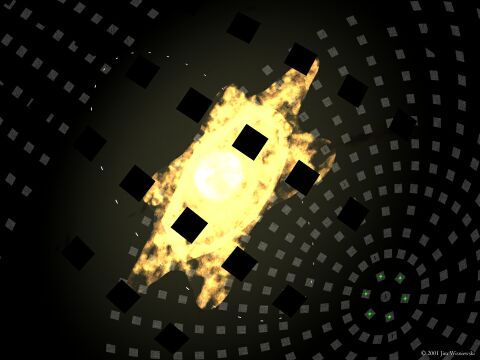 Image from Jim Wisniewski | |
| The star Sirius is surrounded by a partial Dyson Swarm of solar collector satellites, | |
The Dyson sphere (or Dyson shell) was originally proposed by the Information Age physicist Freeman Dyson in the article "Search for Artificial Stellar Sources of Infrared Radiation" as a way for an advanced civilisation to utilise all of the energy radiated by their sun. It is a shell of solar collectors or habitats around the star, so that all (or at least a significant amount) energy will hit a receiving surface where it can be used.
Dyson Swarms collect vast amounts of energy, which can be used to support many small habitats, or a number of larger habitats or inhabited megastructures. Often, however, the energy is used to support computation, and most of the high Archai use Dyson swarms or shells as parts of their processing substrate.
Many people, even in the Orion's Arm civilisation in the eleventh millennium, still think of a Dyson sphere as a solid shell, with living space on the inside facing upwards to the star; this configuration is impossible even using Orion's Arm technology. However many dyson shells (especially those associated with the Efficiency Maximisation Paradigm) contain virtual worlds, including the famous Impossible Dyson, which has a simulation of a full-sized inverted dyson sphere with trillions of virtual inhabitants..
A G class star like Sol has an energy output of around 3.8e26 Watts, of which most would be available to do useful work.
There are four main types of Dyson shell in use across Terragen civilisation:
Dyson Swarms
Dyson Bubble or Statites
Suprastellar Shells
Partial Dyson Shells
for more details see sections below.
Dyson Swarms
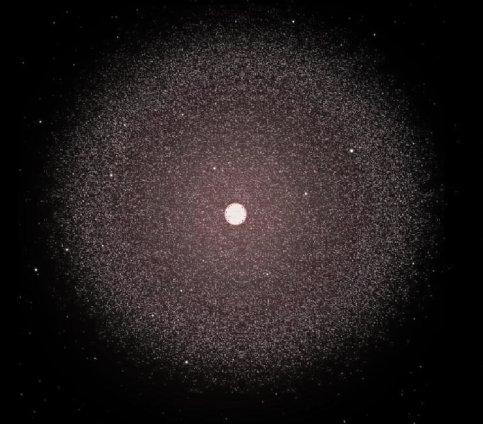 Image from Steve Bowers | |
| A Spherical Dyson Swarm | |
Dyson's original idea was a swarm, not a shell, containing enough solar collectors around the star to absorb the starlight, containing at least 10,000 elements and around a million kilometers thick; here is one, radiating away the waste heat after the swarm has utilised the star's energy.
Note that waste heat is emitted as redder wavelengths; Freeman Dyson recommended a search for such emission in his original article, and in fact over the millennia such thermal signatures have been detected in numerous locations throughout the observable universe. This indicates that intelligent life is widespread, if not common.
Dyson swarms vary in distances from the primary, as well as individual hab or structure density.
Image from Steve Bowers | |
| A close-up of the pyramidal swarm elements in Oikumene dyson. | |
As far as reasonably comfortable (baseline friendly standards) habitats are concerned, most of the swarm might be a distance out equivalent to the position between the orbits of Venus and Earth, or Venus and Mars, in SolSys. Since part of the purpose of all this is to maximise interception of sunlight, most tend to be the former size.
The average distance between the two orbits is roughly 1/3 of an AU or about 31 million miles. This is enough to fit some 3875 earths edge to edge. This volume extends completely around the sun in all directions. So even for really large Bishop ring style habitats there is still plenty of room. Even when using Banks orbitals one could still fit between 3 and 30 rings edge to edge in the space from one orbit to another.
Configuration; Jenkins Swarm
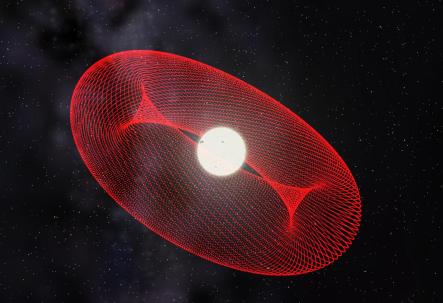 Image from Steve Bowers | |
| This power collection swarm consists of thousands of elements in inclined orbits, each with a slightly different ascending node and pericenter. This arrangement ensures the elements never come close to each other. The various orbits form a toroid shape, surrounding the star. | |
Often the swarm is organised into two or more concentric tori at right angles to one another, a configuration which gives longer term stability while allowing most of the energy to be captured.
Configuration; Snailshell Swarm
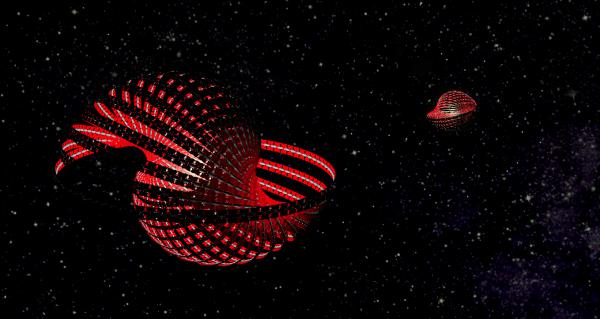 Image from Steve Bowers | |
| The twin dyson swarms of the Black Acropolis are arranged in a 'snailshell' configuration. | |
By surrounding the star with bands of power collectors or habitats at different radii and inclination the entire star can be encapsulated quite simply.
Many swarms have few, or no habitable elements at all, and are simply used for processing by the Archailects and other high toposophic entities; the most efficient form of mind-swarm is the Matrioshka Brain, which has many concentric shells, each one designed to exploit the waste radiation of the shells closer to the star than itself.
Starlifting Swarm
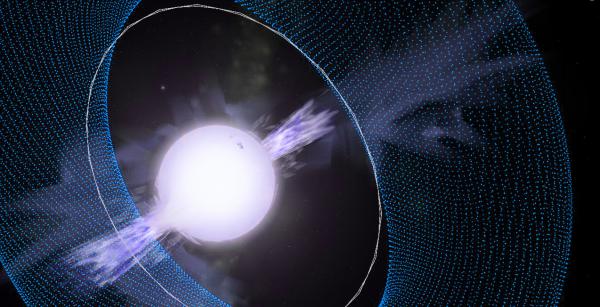 Image from Steve Bowers | |
| The energy required for starlifting is extracted from the stars' light by a toroidal swarm of satellites in mutually inclined orbits; the energy is used to magnetically constrain the star so that it expells matter from the poles. By removing the outer layers the pressure on the core is relieved, extending this star's life. | |
Swarms may be used to provide power for starlifting projects; the energy collected is used to power massive superconducting magnet rings, which stimulate the star to expel matter in the form of controlled polar jets.
Once a considerable amount of matter has been extracted, it may be used to create a Matrioshka Hypernode, a very efficient form of computronium megastructure.
Dyson Bubble, Dyson Statite
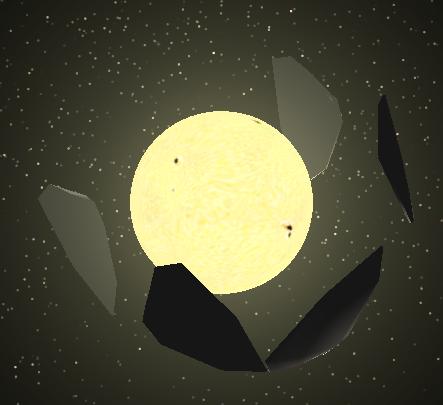 Image from Steve Bowers | |
| A partial statite bubble surrounds the giant yellow star Sadalmelik | |
A second type of Dyson uses lightweight sails to float on the light pressure from the star; these floating satellites are called statites and can support the weight of photovoltaic cells- these dyson statites are basically an energy collection device, but as they are close to the star they can be quite efficient. The collected energy can be beamed to remote locations for use in life support, industry, computational processing, or transport; these beams can also be used for defense or communication. Energy can also be stored using antimatter or other storage media.
Suprastellar Shells
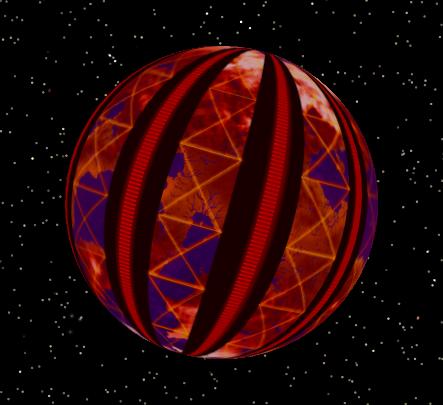 Image from Steve Bowers | |
| The Dreamspheres in the Umma Shell are dynamically supported shells surrounding brown dwarf stars. The surface of this shell glows dull red due to the waste heat from the brown dwarf star beneath the surface. | |
These shells have solid surfaces which are actively supported by dynamic orbital beams; the local gravity is towards the stars, so inhabitants live on the outside. The outside of these shells naturally faces interstellar space, so are dark; this means that the surfaces of suprastellar shells must be illuminated artificially.
A proportion of the energy collected by the shell is used to mainatain the dynamic rings which support the shell, but the rest is available for computation, manufacturing or life support.
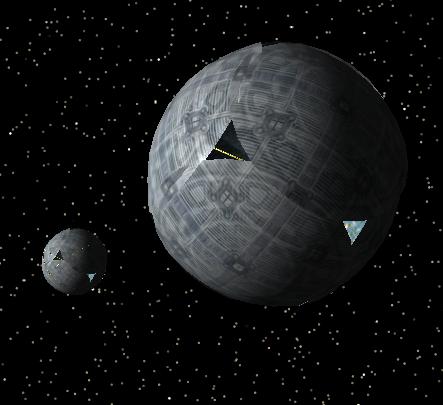 Image from Steve Bowers | |
| The Kiyoshi Dysons at Xi Scorpii have several concentric dynamically supported shells with habitable surfaces sandwiched between them. The outermost surface also supports a biosphere. | |
Virtual Worlds
Some suprastellar shells are not inhabited by bionts but contain vast processing substrates, some of which, particularly those associated with the Efficiency Maximisation Paradigm and the Panvirtuality, contain vast simulated worlds.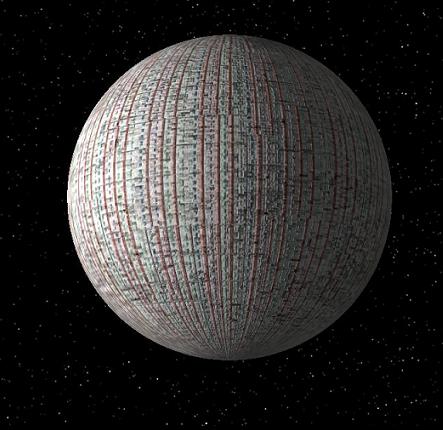 Image from Steve Bowers | |
| Particularly notable among these virtual worlds is the one contained within the so-called Impossible Dyson at 18 Scorpii | |
The Impossible Dyson Sphere at 18 Scorpii contains a simulation of an inverted living space on the underneath of the shell, complete with a surface area 600 million times that of old Earth, and a current population of twenty-two trillion virtual inhabitants. This is the most detailed simulation of an inverted Dyson Sphere in the Orion's Arm Civilisation; only in such a simulation is it possible to exist on the inside of a hollow sphere with the sun at the centre.
Partial Dysons
A habitable megastructure can be built as a Partial Dyson which intercepts only part of the star's energy. This sort of megastructure can still be very large, and can be either in orbit around the star or supported dynamically.Ringworld
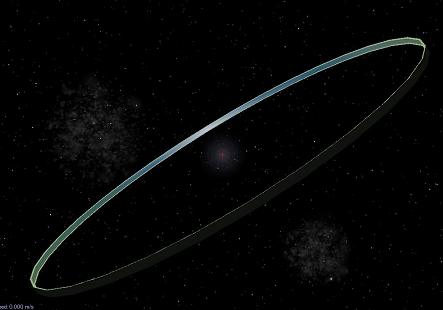 Image from Steve Bowers | |
| Ouaddai system contains an example of a Ringworld: a partial dyson shell which rotates around the star to produce gravity outwards from its centre. The Ouaddai ringworld is partially supported dynamically. | |
Topopolis
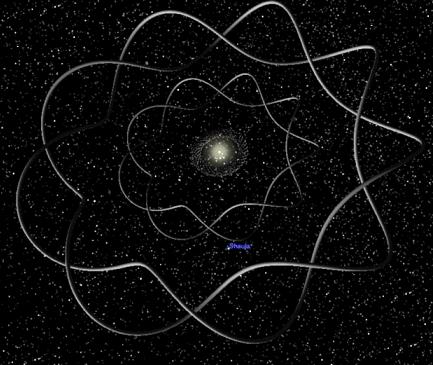 Image from Steve Bowers | |
| The multiple topopoli of Cableville are examples of a tube-like orbiting megastructure which encompasses the star; the tube rotates around its long axis to produce centrifugal gravity on the inside surface. | |
Kepleria
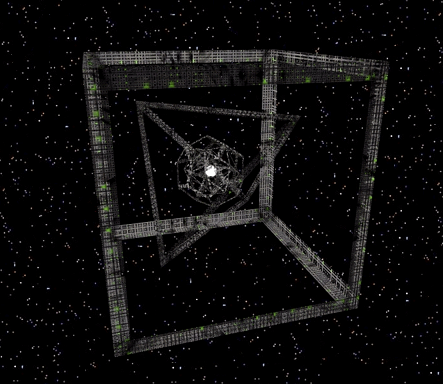 Image from Anders Sandberg | |
| Other partial dyson shells such as Kepleria support themselves using drive sail technology or by other exotic means. | |
Over the millennia most inhabited planetary systems have constructed a power collection swarm of some sort, generally quite small, often intercepting only a fraction of the starlight. Some swarms project collimated sunbeams outwards towards inhabited planets, thereby supplying distant worlds with adequate amounts of heat and light. More powerful versions of such beams can be used as defensive (and, on rare occasions, offensive) weapons.
One ancient, alien (Xenosophont) dyson swarm exists within the extent of the Terragen Sphere; this is known as the Black Acropolis and consists of millions of power collection satellites and hundreds of separate habitats, with several different types of environment inside. Some of thes environments in this swarm are suitable for lightly adapted humans. Other Dyson swarms or spheres have been detected at great distances outside the Terragen region, including some in the High Energy Emission Civilisation known as HEEC 6 within our galaxy, and in many other galaxies using powerful telescopes linked to the Argus Array.
Communication Links within Dyson and Matrioshka Brains
A Dyson shell can support vast amounts of processing power, especially if arranged in conentric shells as a so-called Matrioshka Brain. Many of these megastructures contain intelligent entities of high toposophic level. However the great size of the shell or swarm means that coordinated thinking would be a very slow process, as information takes several minutes, moving at the speed of light, to pass from one side of such an object to the other A brain the size of a solar system can be a very slow thinking entity indeed, but a number of measures can be used to speed the thought process up somewhat.Unlike a biont or vec brain, the neurons or individual processing elements are constantly moving relative to each other. Because the individual structures and habitats are moving in this way, there is the need for maintaining lines of communication ("synapses" in the case of a Dyson Node) to be maintained between them for the greatest amount of time possible, to allowing for efficient operation and memory storage and retrieval.
There are several solutions, which are generally used together.
For 'conventional' data transmission the best way to keep everything linked would probably be a combination of radio broadcasting and laser communications. Broadcasts, especially if relayed thru spaced repeaters, would be largely immune to line-of- site issues. Use of multiple frequencies would allow lots of different types of info to be sent simultaneously.
Using lasers, different habs/nodes can maintain links through sets of relay satellites. As long as any two or more nodes were within line of site of a series of satellites they could maintain contact. As each relay or node moves along in its orbit, it can 'hand off' data transmissions between components such that the replacement data link can be established with a relay that is approaching before contact is lost with the relay that is moving away.
Finally, using a wormhole bus many of these issues can be mitigated since wormhole-linked comm-stations are able to remain in continuous, almost instantaneous contact with each other without regard to their relative positions in space. In principle, it is possible to use a combination of 'normal space' and wormhole-based comm-relays that act to maintain contact throughout the system, and permit rapid data transfer without concern for the relative locations of each station.
Such compact wormholes are generally known as 'Hayward wormholes' or 'comm-gauge holes' and are very small but very massive; only a Hayward wormhole can exist within a dyson swarm, as full-scale traversable 'holes must be located far away from massive objects.
Related Articles
Appears in Topics
Development Notes
Text by Todd Drashner and Steve Bowers with extra material by Mike Parisi and M. Alan Kazlev
Initially published on 15 June 2010.
Initially published on 15 June 2010.
Additional Information
Anders Sandberg's Dyson Sphere FAQ.
Isaac Arthur's YouTube Channel:
Dyson Spheres
Isaac Arthur's YouTube Channel:
Dyson Spheres






